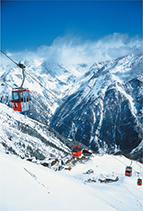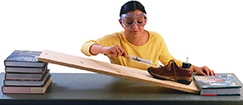Quick Lab
Using Friction to Change Mechanical Advantage
Materials
6 books, board, 3 different kinds of shoes, 1-kilogram mass, spring scale
Procedure 
Create a stack of five books. Make a ramp by leaning the end of a board against the top of the stack. Place a sixth book at the bottom of the ramp to keep the board from sliding down off the stack of books.
Attach the spring scale to a shoe. Place the mass in the shoe. Suspend the shoe with the mass from the spring scale. Observe and record the force reading on the scale.
Place the shoe containing the mass on the bottom of the ramp as shown.
Use the spring scale to pull the shoe up the ramp at a slow constant speed. Observe and record the force reading on the spring scale.
Predicting Record your prediction of the force needed to pull the mass up the ramp in each of the other shoes. Investigate your predictions by repeating Steps 2 through 4 for each shoe.
Analyze and Conclude
Calculating Determine and record the actual mechanical advantage of the ramp for each shoe. To do this, divide the force measured in Step 2 by the force measured in Step 4.
Comparing Which shoe resulted in the largest mechanical advantage? The smallest mechanical advantage? Explain these results.
Drawing Conclusions Which shoe required the most force to pull it up the ramp? What did this additional force accomplish? Explain.
Figure 10 The cable supporting the gondola forms an inclined plane, a type of machine. The inclined plane is used to move people up to the top of the mountain.

Calculating Mechanical Advantage
Ideal mechanical advantage is easier to measure than actual mechanical advantage because it depends only on the locations of the forces and the distances over which they act. To calculate the ideal mechanical advantage of any machine, divide the input distance by the output distance. Remember that the effects of friction are neglected when calculating ideal mechanical advantage.
Ideal Mechanical Advantage
The gondola in Figure 10 makes use of the inclined plane formed by its supporting cable to more easily move people uphill. The increased horizontal distance (input distance) is greater than the vertical gain in height (output distance). Thus the inclined cable gives the gondola a mechanical advantage greater than 1.
 What two quantities must you know in order to calculate ideal mechanical advantage?
What two quantities must you know in order to calculate ideal mechanical advantage?





